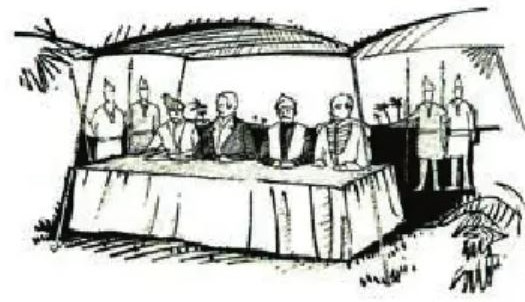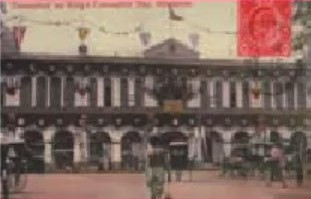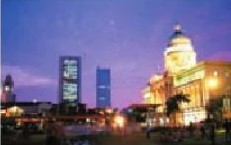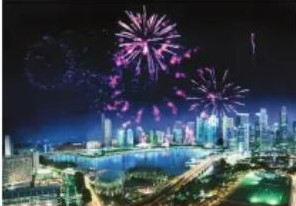Marching Through the Decades: Singapore on Parade, an Online Exhibition
On 9 August every year, Singaporeans look forward to the National Day Parade to celebrate Singapore’s independence. The “Singapore on Parade” online exhibition aims to recapture the fine moments and grandeur of grand parades held in Singapore from colonial to modern times.

Parades For All Seasons
…The ceremonies you have seen today are ancient, and some of their origins are veiled in the mists of the past. But their spirit and their meaning shine through the ages never, perhaps, more brightly than now…
Queen Elizabeth II. Excerpt from broadcast made on the evening of the Queen’s Coronation, 2 June 1953.
Source: British Monarchy. (n.d.). The Queen’s speeches. Retrieved 10 May 2006, from https://www.royal.uk/.
Most people love parades for they are festive and escapist; day-to-day tasks take a standstill as people congregate at common venues to treat themselves to a spectacle of precision, colours loud music and fireworks. Parades are timeless symbols of unity as they transcend ethnicity and age, and showcase icons of progress that everyone can identify and be proud of.
On 9 August every year, Singaporeans look forward to the National Day Parade (NDP) to celebrate their independence. Military drills, band performances, fly- and march-pasts and fireworks never fail to excite us. As Singapore prepares for her 41st NDP on 9 August 2006, we reminisce the country’s commitment to this pageantry to commemorate the occasion through the Singapore on Parade online exhibition. This exhibition aims to recapture the fine moments and grandeur of the grand parades in Singapore from colonial to modern times. The ceremonies in pre-independence parades were of British conception and carried messages of British empire-building. But traditions die hard and many of the parade rituals seen then have continued into present day NDPs. The main difference lies in the spirit and meaning; while pre-independence parades rejoiced at Singapore’s patronage to the greatest empire on earth, NDPs celebrate Singapore’s triumph as a nation united by the country’s own defined ideals of progress.
Parades of Yesteryear

Perhaps it is not widely known that the history of parades in Singapore is as old as the history of the settlement. The founding of Singapore on February 1819 was ushered in with a parade. Indian sepoys and European artillerymen were among the first to stamp their feet on the Plain (now the Padang) in cohesion, while offshore the guns from the ships roared when the Union flag was hoisted up. Pomp and gallantry certainly did not escape this historic ceremony. A hundred years later, another parade and other festivities took place in Singapore to mark the 100th anniversary of the colony’s founding. The colony had survived and thrived, a milestone worthy of a Centenary Day celebrations. On 6 February 1919, the Centenary kicked off with a parade at the Victoria Theatre and Memorial Hall and the unveiling of a commemoration tablet on the newly relocated Raffles Statue. The statue was moved from the Padang to the Memorial Hall for this occasion.

Colonial parades burst into the streets in kaleidoscopic scale during Queen Victoria’s reign (1837–1901). She ruled the longest and was the most celebrated sovereign in Singapore though her successors were no less prominent. From Queen Victoria to Queen Elizabeth II, Singapore paid homage to her British sovereigns through countless parades; birthday parades, Empire Day parades, coronation parades, and Golden, Diamond and Silver jubilee parades.

From the late 19th century, the celebration of British royal events (coronation, birthday and jubilees) had spilled over from London to the various colonies. As shared occasions across the Empire, these events were celebrated with a common style, involving banners and flags, speeches and street parties, military processions, the unveiling of statues or the opening of memorial halls. Not to be outdone, Singapore’s version of the celebrations had enough buntings and illuminations to turn the whole town into a magical fairyland. The newspaper became an important tool to announce the various programmes scheduled for the celebrations. Each ethnic group had their own way to show support to the sovereign on these occasions; the Arabs decorated an arch they constructed with “God Save The King” neon lights; the Jews held special prayers at the synagogue; the Chinese, Malays and Indians combined to organise a procession, even the Japanese community contributed firework displays.

People’s Parade: A Flawless Symphony

Over the decades, parades have become distinctly Singaporean. Modern day NDPs have evolved into “people’s parade” where everybody participates. From the mass displays and fireworks to the reciting of the National Pledge and singing of the National Anthem, everyone has a role to play. This hearty mobilisation requires high-level coordination and reiterations to ensure a flawless execution of NDPs. Riding on the adage “practice makes perfect”, rehearsals have become a must in every NDP. The Singapore on Parade online exhibition showcases the brilliant formations that were strung together by each participant, no doubt after many practices, as well as some behind-the-scene footages to depict the enormous preparations before the big event.

The Hosts of Parades

Parades in colonial Singapore were an important tool to brand British imperial rule on the colony. As the power and prestige of the British declined after WWII, the focus of parades shifted from the British monarchy to the nation-state. National symbols – the flag, the pledge and the national anthem – replaced imperial ones. One icon that bucked the trend was the Padang. The open field which hosted many grand parades in the past was still the venue of choice for NDPs until 1976, when Singapore held her first NDP at the National Stadium. Singapore experimented with the concept of “one parade many venues” for several years where NDPs were held at several stadiums. This “decentralised” celebration format lasted until 1984 (in alternate years); thereafter the government reverted to one venue for the NDP partly due to the huge costs of organising many mini parades. The Padang once again rose to the occasion when it hosted Singapore’s 40th NDP in 2005.

National Day Celebrations Fast Forward

As a city that is still fast evolving, the look and feel of National Day celebrations is also expected to move with the times. A new downtown at Marina (together with the proposed Integrated Resort) is one of the exciting developments in Singapore. It is also a site chosen by Prime Minister Lee Hsien Loong to chart a new National Day celebrations experience. During his second National Day Rally speech on 21 August 2005, PM Lee treated Singaporeans to an advanced sneak preview of fireworks by the Marina Bayfront on 9 August 2015, Singapore’s 50th Birthday. The animation clip of the vision was put together by students from Nanyang Polytechnic.
Senior Reference Librarian
Lee Kong Chian Reference Library

